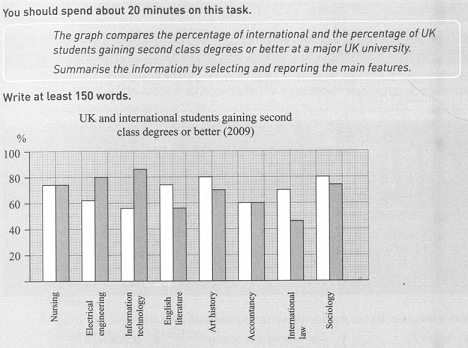nguoi_co_doc
Aug 7, 2014
Writing Feedback / IELTS: the figure reflect equally in subjects related to service community; foreign and UK students [4]
The bar chart illustrates the differences between the proportion of foreign students and UK students in terms of obtaining the second class degree or tertiary education at a university of United Kingdom in 2009.
It is evident that both home and international students were passionate about learning with more than a half achieving second level or higher education. In addition, the abilities of students depend on the group of subjects studied.
International students dominated in the technology-related syllabus. In particular, a vast majority of foreign students ( nearly 80%) became electrical or IT engineers, compared to approximately 60 per cent of UK students did so.
Conversely, domestic students outnumbered in curriculums related to language, art, law and society behavior. Whereas roughly three quarters of UK students persuaded English literature as well as International law, only 50 per cent non-domestic students gained this field. Furthermore, the gap rate between two groups of students took the course about Art and Society was quite low, which 0.8 for UK students and 0.75 for international students.
Interestingly, the figure represented equally in subjects related to service community. Nursing and Accountancy, for examples, were 75% and 60% respectively for both UK students and international students.
The bar chart illustrates the differences between the proportion of foreign students and UK students in terms of obtaining the second class degree or tertiary education at a university of United Kingdom in 2009.
It is evident that both home and international students were passionate about learning with more than a half achieving second level or higher education. In addition, the abilities of students depend on the group of subjects studied.
International students dominated in the technology-related syllabus. In particular, a vast majority of foreign students ( nearly 80%) became electrical or IT engineers, compared to approximately 60 per cent of UK students did so.
Conversely, domestic students outnumbered in curriculums related to language, art, law and society behavior. Whereas roughly three quarters of UK students persuaded English literature as well as International law, only 50 per cent non-domestic students gained this field. Furthermore, the gap rate between two groups of students took the course about Art and Society was quite low, which 0.8 for UK students and 0.75 for international students.
Interestingly, the figure represented equally in subjects related to service community. Nursing and Accountancy, for examples, were 75% and 60% respectively for both UK students and international students.

Untitled.png
